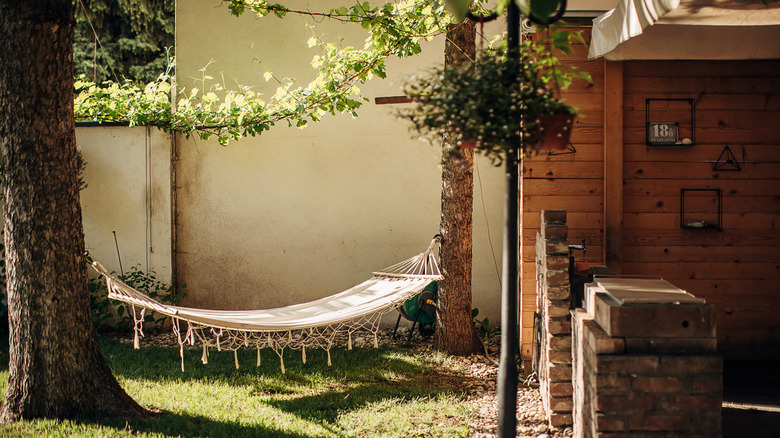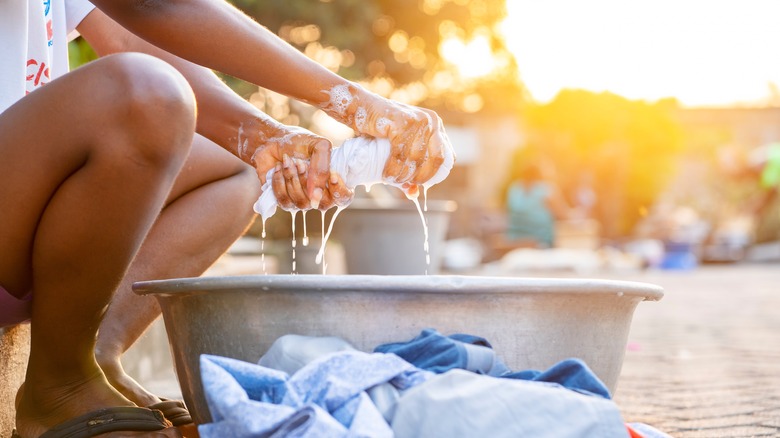The Best Way To Clean Your Hammock To Get It Ready For Sunny Summer Days
In the depths of winter, the balmy season might seem far away, but one of the most enjoyable ways to get through the dark and cold of winter is to prepare for warmer days ahead. That means taking your hammock out of storage and giving it a once over. After all, few things make your backyard more relaxing than a hammock swinging between the trees. Plus, no one wants to have to panic-replace a hammock at the end of May when prices skyrocket. Hammocks can be washed by hand using a laundry brush and gentle detergent and, in some cases, thrown in the washing machine (light cycle only) — both options work equally well.
First, identify your hammock type. The classic backyard hammock is made from rope — cotton, hemp, or a synthetic material like polyester — woven into a net. Sometimes, the rope culminates at a hook at each end; some rope hammocks are held open by two wooden or metal frames called spreaders. Those wide, rainbow-fabric hammocks you see at beach resorts in Hawaii or Bali, often considered the most comfortable hammock style, feature a length of natural or synthetic woven or quilted textiles. Some are even made from parachute silk! Camping hammocks are typically constructed from lightweight nylon. They have sturdy stitching, built-in attachments, and sometimes special features like rain covers and storage compartments. Beloved by hikers, these compact hammocks dry quickly and pack down small.
Get cleaning
To wash a rope or fabric hammock by hand, head outside. You'll need a large tub (a kid's inflatable pool is ideal), a soft-bristled brush, like this Murchison-Hume laundry brush for $16.00, and some gentle liquid laundry soap. The Laundress sells a well-reviewed 16-fluid-ounce bottle of delicate wash for $30.00. Put the hammock in the pool and spray it with water — a garden hose or watering can work great. Add a splash of laundry soap and rub it through the hammock with your hands. Scrub the ropes or fabric with the soft-bristled brush, creating a good lather. Keep the fixtures, like wooden spreaders and steel hooks, out of the water throughout the cleaning process.
Once the hammock body is clean and dry (let it air dry rather than put it in your dryer), check all the attachments for damage. Noticing corroded metal hooks and rings? A ball of aluminum foil will remove stubborn rust from your outdoor furniture, metal hammock fixtures included. Sand and re-varnish wooden spreaders if they look dry and lackluster. You might be able to run your cotton, polyester, or nylon hammock through the washing machine, but only if it has detachable fixtures, like carabiners. Use your machine's delicate setting, cold water only, and the aforementioned gentle detergent. As before, hang the hammock outside to line dry. If in doubt regarding the machine-washability of your hammock, check the manufacturer's instructions.
Ongoing care
Don't put in all this effort for nothing. Where you hang your hammock for the summer will determine if it will stay clean the entire season. If you plan to leave it up for a few months, select a sheltered spot, like in a covered patio or under a stand of sturdy trees. If you choose the latter, check the hammock for fallen leaves and twigs before you get in it — each and every time. You can also use a custom-designed hammock stand; it's a metal or wooden cradle-like frame to which you hook each end of your hammock. Ideally, hang your hammock in an area that gets dappled shade. Too much direct sunlight can cause the fabric to fade or deteriorate.
To increase the life of your hammock, never leave it outside year-round. It could get damaged by adverse weather, curious wildlife, or even stolen. Likewise, if bad weather is forecast — say, a summer storm — take your hammock down before it reaches you. Not all hammocks can withstand prolonged exposure to excessive rain, wind, or worse, hail. At the end of the summer, clean your hammock again as directed above, let it dry completely, and store it in an airtight container.


